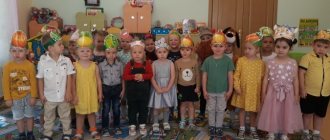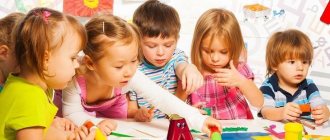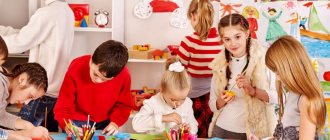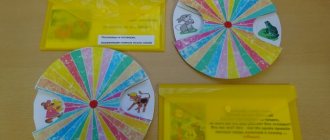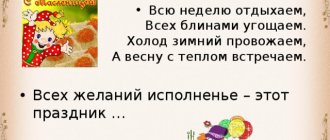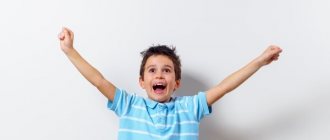Progress of activities:
Educator: Guys, Mishka came to visit us!
Bear: Hello, guys!
Children: Hello, Mishka!
Mishka holds an envelope in his paws.
Educator: Bear, what did you bring us?
Bear: I found this letter. I read and read it, but didn’t understand anything.
Educator: let us help you, Mishka. We take out the letter, and there is a riddle :
Who from the tall dark pines
Did you throw a cone at the kids?
And into the bushes through a stump
Flashed like a light?
Educator: The bear is a mystery . They are different and can be about everything in the world.
Bear: Oh, how interesting! Do you like to solve riddles ? (Yes)
Bear: Do you know how to make ? (Yes)
Bear: Tell me, please, where can I find riddles ?
Children: Riddles can be found in books. You can remember the riddles that were taught. Or you can ask mom (dad, etc.) to make a riddle . Or you can come up with riddles .
Bear (surprised)
: Make up your own
riddles !
And how to do it? Educator: Guys, can we help Mishka? (Yes)
Let's teach him
how to make riddles .
Bear: Oh, I accidentally grabbed pictures with different animals . riddles about them ?
The teacher hangs pictures of domestic and wild animals .
We all look at these pictures together and name the animals .
Educator: Guys, to make it easier for us to come up with riddles , we have pictures to help. Let's remember what they mean.
1 picture: Christmas tree and house - where does the animal ? therefore, whether it is wild or domestic;
Picture 2: large and small square - what size is the animal ? (big or small)
;
Picture 3: skin – what is the body covered with? (wool or needles)
;
4 picture: rainbow – what color;
5 picture: food - what he eats;
6 picture: exclamation point – features of this animal , how it differs from others.
We turn the easel with the magnetic board away from the children. Then, if desired, the child goes out, chooses an animal , about which he will come up with a riddle and tells the teacher in his ear. Children listen to their friend's riddle and guess it. The child shows a picture of the animal he wished for and compares it with the children’s answers. Then the children add information about this animal and interesting facts from their lives.
After two or three riddles, a physical exercise is held in the form of a simple saying:
Apa-apa-apa - the wolf’s paw hurts.
Ape-ape-ape - a wound on the paw.
Apu-apu-apu - we will treat the paw.
Up-up-up - the wolf has strong paws!
Then we continue to listen to children's riddles .
At the end of the lesson , we summarize.
The teacher turns to Mishka: Mishka, did you like our riddles ?
Bear: yes! Coming up with riddles is so interesting ! Can I also try to tell you a riddle ? According to this scheme, Mishka comes up with a riddle about some unnamed animal . The children guess it.
Mishka thanks the children for their help and invites everyone to play the game “Funny Animals”
.
"In the world of wild animals." Summary of an open lesson on speech development in the middle group Program content: Open lesson “In the world of wild animals” (for the middle group) Educational: expand and clarify children’s knowledge.
Summary of direct educational activities in the senior group “Compiling descriptive riddles about animals” Summary of direct educational activities in the senior group “Compiling descriptive riddles about animals” Tasks. Connected speech:.
Summary of educational activities for speech development in the middle group. Topic: “Composing a story based on a toy” Summary of educational activities for speech development in the middle group. Topic: “Making a story based on a toy” Purpose: To teach children to write a short descriptive story.
Summary of a lesson on speech development for the middle group “The World of Pets” Program content: to consolidate children’s knowledge about domestic animals and their cubs (habits, feeding habits, living conditions, methods.
Summary of a lesson on speech development “There is a tower in a field. Making up riddles" Summary of the lesson on speech development "Teremok is standing in the field" (middle group) Completed by the teacher of Group No. 14 Loginova N. A. MBDOU.
Perform developmental exercises from Ikyusha
Mathematics
Reading
The world
Logics
English language
What riddles are the most popular among children?
Of course, about animals! This is due to the strong influence of Russian folk tales, in which many stories are dedicated to forest dwellers. Fairy-tale heroes are always endowed with bright characters, so readers empathize with them, and we can draw clear conclusions from the plot of fairy tales. The characteristics of the animals that we meet in fairy tales often form the basis of riddles-descriptions and riddles-questions about animals: “He walks around in the cold winter, angry, hungry” - a wolf.
"Miracle - riddles for children"
- January 21, 2013
“The riddles reflected the people’s views on nature and the environment;
in it, more ancient in form and origin, full scope was opened for the creative imagination of the people” D.N. Sadovnikov.
In our work, we teachers very often use riddles. We don’t think about what it is. This prompted me to research the topic of Riddles and write an article. In the article I talk about the purpose of riddles, reveal the concept, main feature and purpose of creating riddles. She touched upon the issue of the conditions for guessing riddles, the order of mental operations when solving riddles. She also selected the material and introduced it to teachers in kindergarten. I used it in classes with children on writing riddles with children. I used the invented riddles at the New Year's party.
I hope the article will be useful for teachers to remember the well-forgotten old things.
Purpose of the riddle.
Man began to create riddles in ancient times, using a riddle as one of the techniques of allegorical, secret language to hide his thoughts and intentions, to protect his home, his family, his livestock, tools, etc. from “evil spirits.” Our distant ancestors were afraid of “evil spirits”, “evil words”, “evil eye” and other dangers that seemed to them to be lurking everywhere. According to their ideas, those who were most at risk were honest, intelligent people, whose positive qualities were usually emphasized by their names - characteristics.
In order to deceive “evil people” and “evil spirits,” caring parents deliberately gave their children “bad names”: smart and handsome boys were called Fools and Freaks, honest and courageous boys were called Scoundrels and Cowards, desirable and dear to the heart were called Fools. It seemed to them that a “bad” name, like an invisible hat, would protect their child from danger and “damage.” Traces of such “preventative” names have been preserved to this day in the foundations of modern Russian surnames such as Nechaevs, Durakovs, Negodyaevs, Glupovs, Gryaznovs and in some nicknames of fairy-tale heroes like Ivanushka - the fool.
Hunters, cattle breeders, and farmers resorted to “secret” speech. They called tools, animals, and hunting grounds not by generally accepted names, but by fictitious words, mysterious phrases or riddles. Riddles were used in diplomatic, military, and trade affairs. Buffoons and beggars widely used allegorical language.
The riddle was not only a “secret” language. With its help, a person’s wisdom, resourcefulness, and education were tested. For this purpose, riddles were included in various rituals: initiation of young men into warriors, wedding ceremonies, and others. The examination role of the riddle is well reflected in myths, fairy tales, songs, and stories. In fairy tales, a riddle was often used as a plot component to test the intelligence and resourcefulness of a character, which determined his future fate, or even life itself.
Over time, the riddle becomes a didactic tool - a means of teaching children. Currently, riddles are used as a fun and effective tool in teaching and raising children.
What is a riddle?
A riddle is a short description of an object or phenomenon, often in poetic form, containing an intricate task in the form of an explicit (direct) or implied (hidden) question.
The main feature of the riddle is that it is a logical task. To guess a riddle means to find a solution to a problem, to answer a question, i.e. perform a rather complex mental operation. The object in question in the riddle is hidden, encrypted, and the methods of deciphering are different. The type of logical task, its complexity, and, consequently, the nature of the mental operation that the guesser has to perform depends on the encryption method.
The riddles reflected the lively, cheerful, lively disposition of the Russian people, who know how to perceive life joyfully, cheerfully, and optimistically. Therefore, riddles are full of humor, jokes, sometimes ridicule, and sometimes mischievous ambiguity. For example: I walk on my head, although I am on my feet; I also walk barefoot, although I am wearing boots. The whole mystery is built on a game of contradictions. What is it like to walk on your head and at the same time on your feet? Barefoot - and at the same time wearing boots? The unexpected answer - “a nail in the boot” - emphasizes the originality of the witty riddle - a joke.
The content of the riddles reflects the life of a person, the reality around him: flora and fauna, natural phenomena, objects of labor, everyday life, and more. With the development of society, the themes and content of riddles change significantly. Modern life is richer and more diverse, so the range of topics reflected in riddles has now expanded significantly. They talk about cultural achievements and technical progress.
The riddles are varied not only in theme, but also in content. There can be several riddles about the same object, phenomenon, or animal, each of which characterizes it in its own way. For example, one riddle about a hare talks about the appearance of the animal - the color of its skin, its short tail, and the fact that it jumps easily: Gray animal hops over hummocks! Light legs and a little tail; in another - about the nature of his movement: Jumps across the field - hides his ears, let's stand in a pillar - ears sticking out; in the third - about the protective ability to change color: White in winter, gray in summer.
The purpose of creating a riddle is to put the interlocutor in a difficult position, as they say, to make him rack his brains, so in it the means of language are used in such a way as to create a deliberate diversity of understanding.
Educational and educational possibilities of the riddle:
- A love for folk art, the native language, living figurative and precise words is formed, the child is introduced into the world of folk poetry, delivering aesthetic pleasure;
- It introduces children to the national mindset, and therefore serves as an effective means of patriotic education;
- Solving riddles is a kind of gymnastics for a child, mobilizing and training his mental strength;
- The ability to carefully observe life, recall what has been seen, compare, juxtapose phenomena, mentally dissect them, highlight the necessary aspects each time, combine, synthesize what is found is formed;
- Resourcefulness, quick wits, quickness of reaction, mental activity, independence, and the habit of understanding the world more deeply and comprehensively develop;
- Guessing riddles sharpens and disciplines the mind, teaching children clear logic, reasoning and proof;
- Solving develops the ability to analyze, generalize, and forms the ability to independently draw conclusions and conclusions;
- Causes interest in the world of things and phenomena, the surrounding reality;
- Contributes to the education of the child’s aesthetic feelings in the reflection of the picturesque landscapes of the Motherland, full of colors, sounds, smells;
- A poetic ear and sensitivity to rhyme develop, the child’s hearing is enriched with a variety of rhythms and melodies;
- Speech is actively developing, vocabulary is enriched, and the ability to correctly express one’s thoughts, putting it into precise verbal form.
Guessing conditions.
Teaching children how to solve riddles requires patience. First of all, an adult should not rush to answer. You also shouldn’t rely only on the child’s natural intelligence. Children should be taught to consciously guess riddles: understand their content, find ways to solve a logical problem, introduce them to guessing techniques, and also learn to explain and prove the correctness of the guess.
Learning the ability to solve riddles begins not with asking them, but with developing the ability to observe life, perceive objects and phenomena from different sides, see the world in diverse connections and dependencies, in colors, sounds, movement and change. And knowledge is acquired through observations, experiments, classes, didactic games, work activities, reading fiction, and walks. Excursions.
The order of mental operations when solving riddles:
- Establish in general terms what to look for.
- Set where to look.
- Identify any remaining signs.
- Put forward an assumption - a guess (hypothesis).
- Combine established characteristics.
- Draw a final conclusion.
For example: the riddle “Guess what kind of hat it is.” A whole armful of fur. The hat is running around in the forest, gnawing on the bark of the bushes.”
1. The hat is running - this is not an ordinary hat, but a living creature. This creature has thick fur, from which you can sew a hat (not a fur coat - an exception). The hat is a small object, which means the creature is small (comparison technique).
2. Question - where? The riddle says in the forest. This means that the animal is not domestic, but wild (exclusion technique).
3. Sign - chewing on the bark of bushes. Neither a bear, nor a squirrel, nor a fox gnaws the bark (exclusion technique). Maybe it's a hare? (assumption, hypothesis).
We correlate all the found signs (synthesis): a small wild animal, lives in the forest, runs through it, its fur goes on hats, gnaws bark. Yes, it's a hare (conclusion).
Literature: Vadchenko N.L., Khatkina N.V. ABC and fairy tales, riddles and tips. – M.: Labyrinth – K, 1998.
Author: Madeeva Nadezhda Borisovna, kindergarten teacher Municipal budgetary preschool educational institution “Kindergarten “Severyanochka” with priority implementation of physical development”, p. Gorki, Shuryshkarsky district, Yamalo-Nenets Autonomous Okrug.
"Journey to the land of mysteries."
Oksana Suvorova(Rekina)
"Journey to the land of mysteries."
"Journey to the land of mysteries."
Goal: continue to teach solving riddles .
Objectives: to clarify children’s ideas about riddles , to teach how to guess descriptive riddles , to consolidate knowledge about the characteristic features of wild animals, to cultivate love and respect for the environment and for animals, to cultivate perseverance, the ability to listen carefully to the teacher, to consolidate the names of animals in speech, to consolidate the use of words, denoting the qualities and actions of animals.
Equipment: toys: hedgehog, fox, bunny, wolf, squirrel, bear, frog, mouse, hats with animal images.
Progress of the lesson.
Guys, now I will tell you an interesting but sad story. When I went to work in the morning, on the porch of our kindergarten I met small forest animals. They all cried bitterly. I asked why they were crying and they replied that they had forgotten their names. I had to reassure them, saying that you and I will definitely find out what their names are. Well, guys, let's help the little animals remember their names? And in order to find out the names of our forest friends, we will need to guess riddles . Ready? Then let's begin!
Fluffy tail - beauty!
Well done! We have already helped the little fox and found out her name. Which one of you wants to be a fox today? Polina will be a fox (I put a fox hat on Polina)
.
Show me how a fox walks, and what kind of fox is it? Polina, where does the fox live in our group? (Polina finds a fox)
. Take Polina with you
little fox, let her also guess riddles . And now the next riddle .
A ball of fluff, a long ear,
Jumps deftly and loves carrots.
Well done! It's a hare! Dima, today he will be a bunny (I’m wearing a bunny hat)
.How does a bunny jump, and how does he gnaw a carrot? Find the bunny in the group, Dima. Let him sit next to you.
He is prickly, but not a Christmas tree,
In needles, but not pine.
It can curl up into a ball.
And Ksyusha will be a hedgehog (I put on a hedgehog hat)
. What hedgehog? Show me how he puffs. Find the hedgehog, Ksyusha. Take your hedgehog with you.
She immediately ran into the hole.
What kind of baby is this?
Well done! Who will be the mouse? Sonya will be the mouse. Sonya, how does the mouse squeak? (I put on a mouse cap)
. Find the mouse, Sonya, plant it next to you.
Guys, we have worked hard, let's play. Now we will show how the weather changes. Game “The wind is blowing in our faces”
(2-3 times)
.
And now, we must help other little animals find out their names.
Who sucks their paw in winter?
He also loves honey.
Can roar loudly
Who will be the bear? Seryozha (putting on a bear hat)
will be a bear.
Show me how a bear walks and how it roars? Find the bear, Seryozha. We now have a bear and we can play (Game “At the Bear in the Forest”)
He makes friends with the fox,
For others, terribly evil.
All teeth click and click,
Very scary gray .
And we will have a wolf, Ilyusha (I put on a wolf cap)
. Ilya, how does our wolf growl? What kind of wolf? Find the wolf, take it with you.
Who will be our frog? And our frog will be Styopa (I’m putting on a frog’s hat! Styopa, show how the frog jumps and how it croaks? Look for the frog and put it next to you.
Who will be our squirrel? Mila will be the squirrel (I put on the squirrel’s hat)
! Darling, how does a squirrel jump, and how does it gnaw nuts? Now find the squirrel and plant it next to him.
Guys, we remembered the names of all our animals and invited them all to visit us. I think they are very happy and grateful to us for our help. Even the sun outside the window is smiling - after all, the little animals don’t cry anymore, they laugh, they are happy that we helped them remember their names. Now let’s all sing a song about the sun and show how good it is for our little animals with their own names. Song "Sun"
. We will not say goodbye to our guests, they will go for a walk with us and show us a fairy tale.
Presentation about animals To consolidate and systematize children’s ideas about animals. To form preschoolers’ understanding of the ways animals eat. Deepen.
Source
